Where to dig in?
Every gardener needs a few essential tools to get started. You’ll want a stainless steel hand trowel for planting, pruning shears for trimming, and gardening gloves to protect your hands. Add a round-pointed shovel and garden fork for soil preparation, plus a reliable watering system like a quality hose or watering can. Don’t forget basic safety gear and a simple method for storing your tools. The right equipment makes gardening more enjoyable and effective.
Must-Have Basic Tools in Gardening for Beginners
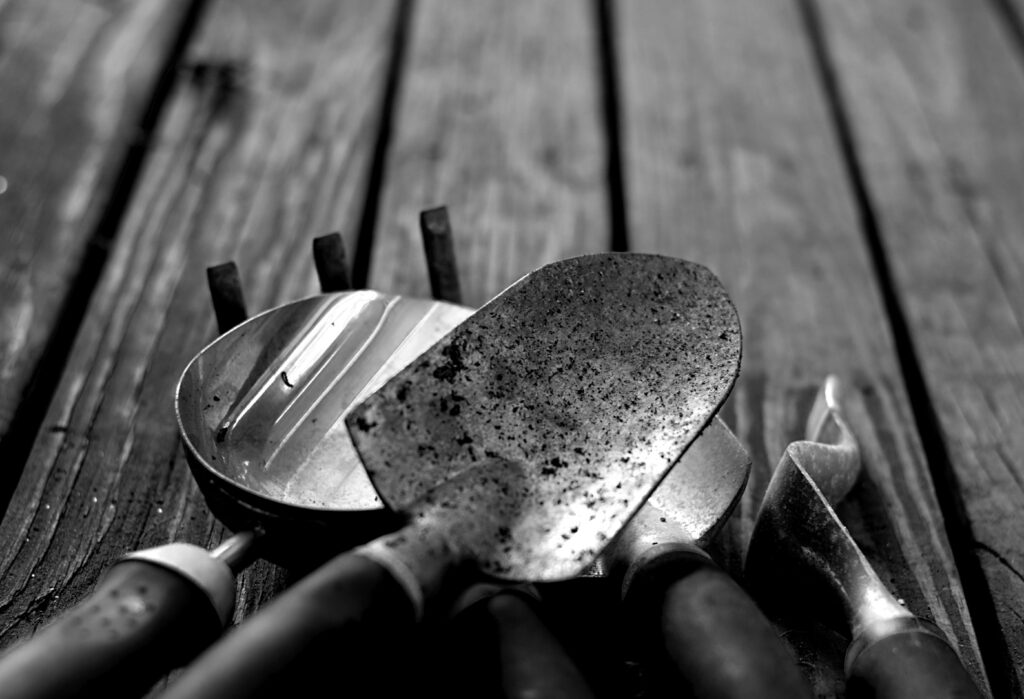
When you’re just starting your gardening journey, having the right tools can make all the difference between frustration and success. Begin with a quality hand trowel, preferably stainless steel, for digging planting holes and transplanting seedlings.
Next, invest in a pair of pruning shears to make clean cuts on stems up to ¾ inch thick, which helps plants heal quickly. Add a hand rake for clearing debris and leveling soil in small spaces. Don’t forget gardening gloves, which protect your hands from thorns, blisters, and soil-borne irritants. For larger soil preparation tasks, a garden fork can efficiently aerate and turn soil, improving drainage and root growth. Before purchasing any tools, it’s important to first plan out your garden considering your available space and what you intend to grow.
For precision planting, consider a dibber to create uniform seed holes and a hori hori knife, which combines cutting and digging functions in one versatile tool. These basics will handle most tasks you’ll encounter as a beginner gardener.
Digging and Soil Preparation Equipment
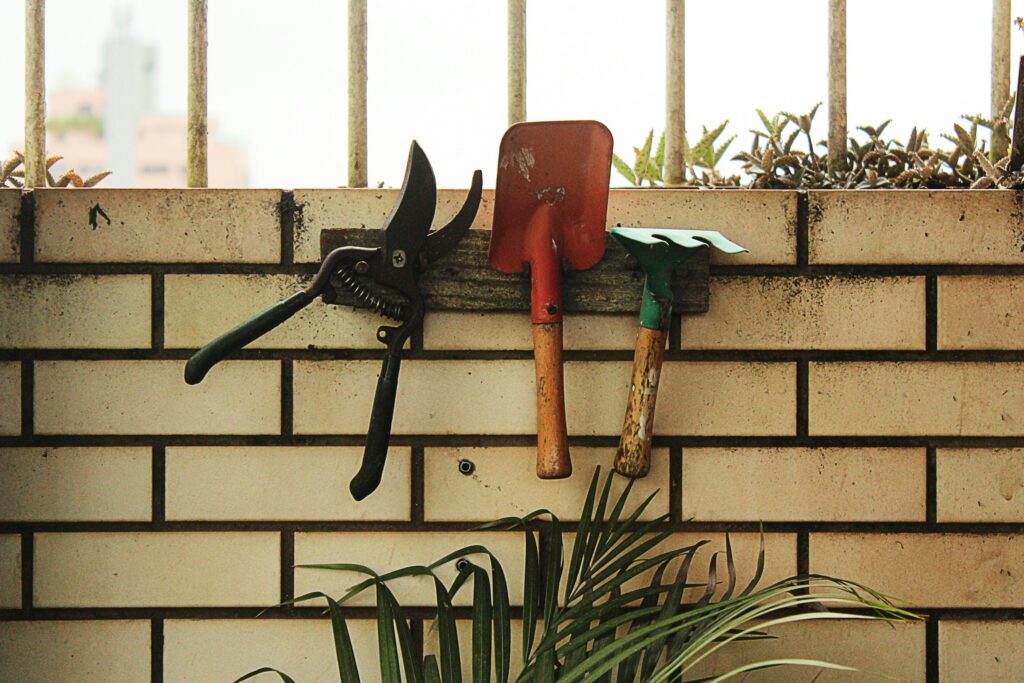
Moving beyond hand tools, serious gardening calls for equipment that can handle larger soil tasks. You’ll need a round-pointed shovel for moving soil and a flat-bladed spade for precise digging and turning over soil beds.
For soil preparation, consider these essential tools:
- Garden forks – perfect for turning and aerating soil without damaging plant roots
- Cultivators – help loosen compacted soil before planting
- Broadforks – ideal for deep soil preparation and improving drainage
- Trowels – necessary for small-scale planting projects
When selecting your digging equipment, prioritize durability and comfort. Look for tools with hardened steel blades and handles that suit your height. Comfortable grips will reduce fatigue during long gardening sessions, while fiberglass or wooden handles offer different benefits depending on your needs. The Zenport Ergonomic Digging Trowel features ergonomic grip design that reduces hand strain during extended planting sessions. For additional eco-friendly preparation techniques, the Grounded in Maine podcast offers excellent advice on sustainable soil management and composting methods.
Watering Systems for Healthy Plants
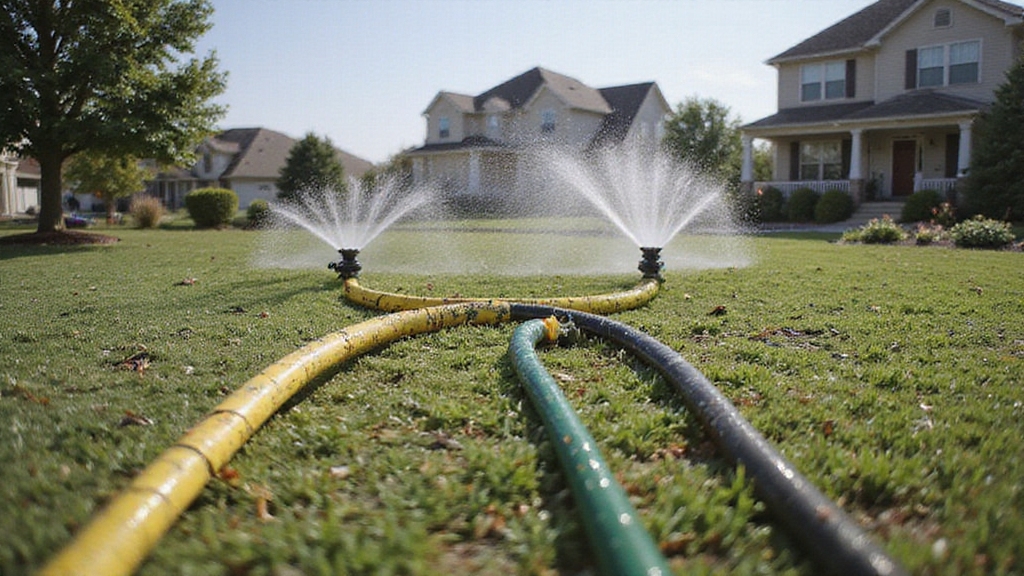
Proper watering forms the foundation of a thriving garden, yet many gardeners struggle to find efficient solutions. You’ll find several watering systems that can simplify this essential task while conserving water and improving plant health.
For most home gardens, consider these effective options:
- Soaker hoses deliver water directly to the soil, reducing evaporation and keeping foliage dry to prevent fungal diseases
- Drip irrigation provides precise water at plant roots, using considerably less water than traditional methods
- Micro spray systems work well for dense plantings and container gardens, offering gentle, controlled moisture
- Overhead sprinklers cover large areas efficiently but may waste water through evaporation on hot days
When selecting your system, consider your garden’s size, plant types, and your region’s climate for ideal results. Expandable hoses like the Hydrotech Pro Series offer lightweight, kink-free alternatives for stress-free manual watering. During cold months, be sure to protect your irrigation equipment by emptying hoses and disconnecting them to prevent damage from freezing temperatures.
Weed Management Solutions
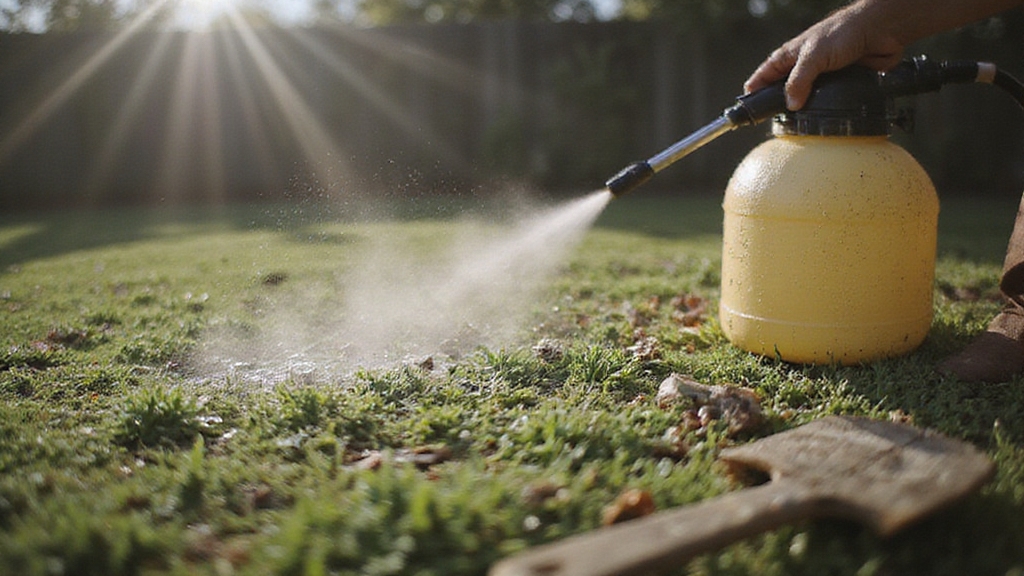
Effective weed control depends on having the right tools at your disposal. Choose your weapon based on the weeding task at hand:
- Stirrup hoes slice through light to moderate weeds easily, making them perfect for regular maintenance.
- Cape Cod weeders excel in tight spaces with their hooked blades that precisely cut roots.
- Dutch hoes let you work standing up, reducing back strain when tackling larger areas.
- Scuffle hoes work with a push-pull motion, ideal for removing young seedlings before they establish.
For chemical-free options, consider weed torches that kill weeds instantly by applying direct heat. Regular garden hoes require a strong chopping motion but are effective for attacking larger weeds that need to be hacked out of tough soil. For persistent weeds that resist manual removal, horticultural vinegar offers an organic alternative to synthetic herbicides. Most importantly, match your tool to your garden’s layout and soil type. Look for ergonomic grips and lightweight designs to reduce fatigue during long weeding sessions.
Garden Safety and Personal Protective Gear
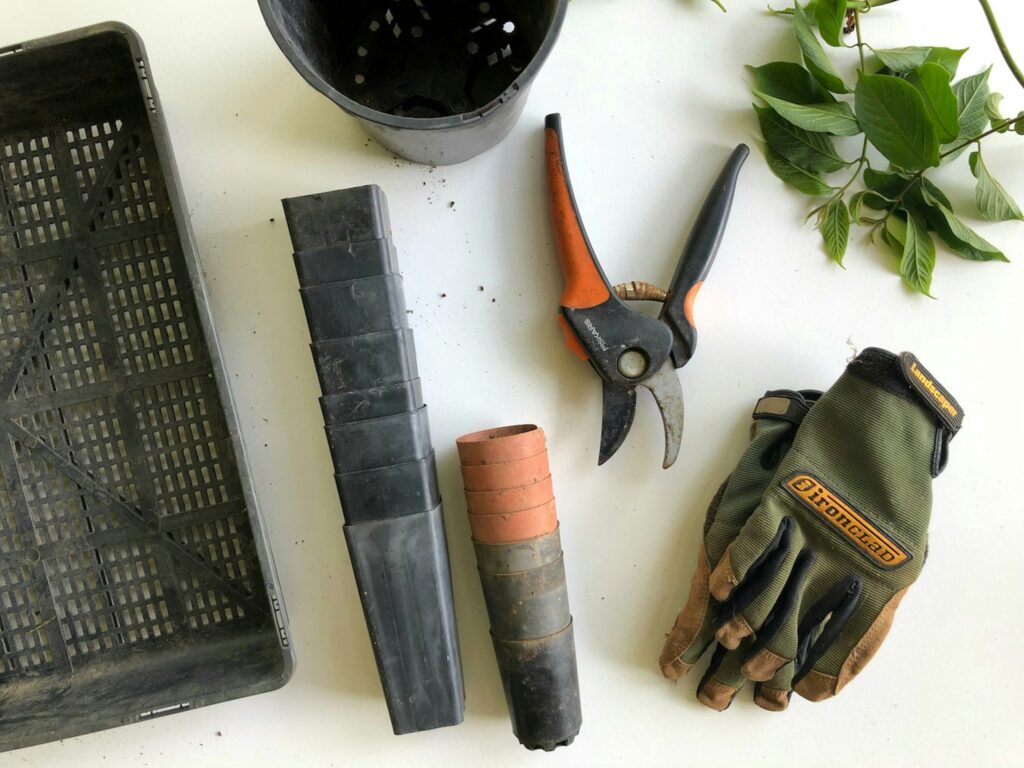
While gardening brings joy and beauty to your outdoor space, it also presents various hazards that require proper protection. Your safety should always be a priority when working with tools, chemicals, and equipment in your garden.
Essential protective gear for every gardener includes:
- Hand and body protection: Wear durable gardening gloves to prevent cuts and blisters, and consider an apron to keep clothes clean while working with soil and plants. Gardening gloves made from waterproof material will provide additional protection against chemicals and moisture. For women, Feverfew Garden Company gloves offer exceptional dexterity with touchscreen compatibility for those who need to use their phones while gardening.
- Eye and face safety: Use safety glasses when operating power tools or when pruning to protect from flying debris.
- Hearing protection: Earplugs or earmuffs are necessary when using loud equipment like lawnmowers or leaf blowers.
- Respiratory gear: Dust masks protect your lungs when working with chemicals, mulch, or in dusty conditions.
Tool Storage and Organization Options
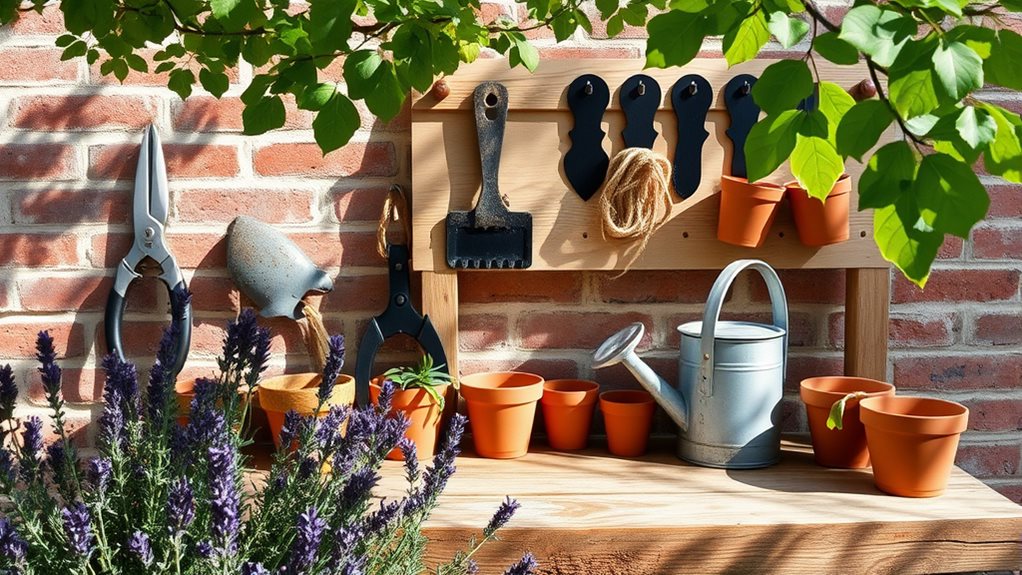
Keeping your garden tools organized and properly stored extends their life and saves you time when tackling outdoor projects. Consider these practical options:
A well-organized garden shed isn’t just tidy—it’s the foundation of efficient gardening and prolonged tool life.
Wall-Mounted Solutions:
- Install pegboards with hooks to hang various tools
- Use magnetic strips for metal tools
- Add shelves for smaller items like gloves and seed packets
Mobile Storage:
- Portable toolboxes keep essentials together
- Garden carts with built-in compartments allow easy transport
- Sturdy tote bags work well for quick garden tasks
Repurposed Items:
- Convert wooden pallets into tool holders
- Hang shoe organizers for small tools
- Use old crates for rustic, functional storage
For larger collections, consider building a dedicated potting shed that provides both storage and a workspace for your gardening activities.
Remember to organize by frequency of use, label containers clearly, and maintain your storage areas regularly to prevent tool damage. Consider incorporating a compost bin to complete your garden setup, with options like the Hotbin Mk. 2 offering temperature control and efficient decomposition.
Maintaining Your Garden Tools for Longevity
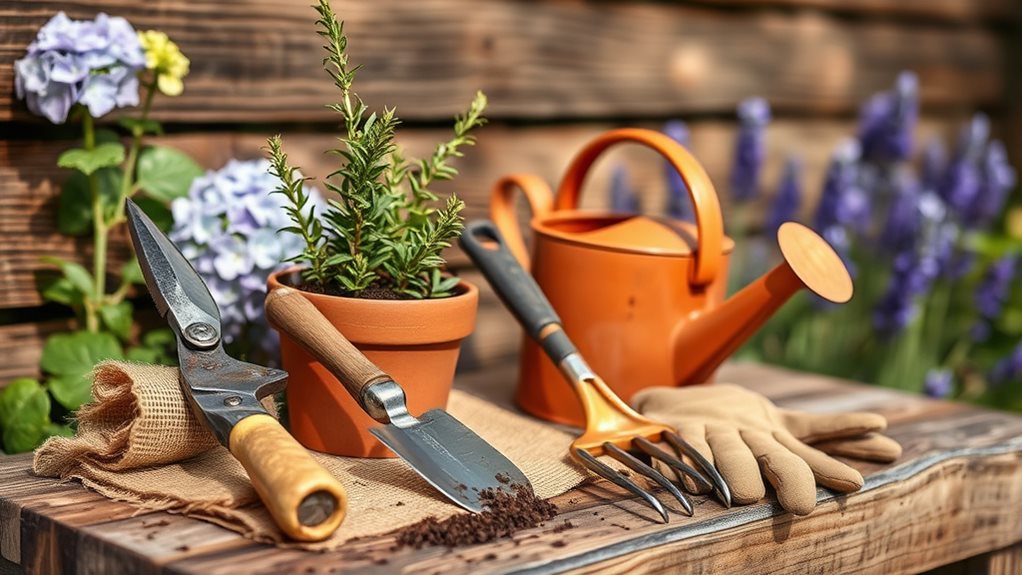
Proper maintenance of your garden tools substantially extends their life, improves their performance, and saves you money in the long run. Clean your tools after each use with water and a stiff brush, then dry them thoroughly to prevent rust. Regular sharpening keeps cutting tools efficient and safer to use. Storing tools properly by hanging them on a wall helps avoid ground contact which can lead to premature rusting. Top brands like Kent and Stowe offer durable tools designed to withstand regular maintenance routines.
Key maintenance practices include:
- Sanitizing tools with disinfectants to prevent disease spread
- Lubricating moving parts on pruners and loppers to reduce friction
- Applying protective coatings to metal surfaces before seasonal storage
- Inspecting wooden handles for cracks and splinters regularly
Develop a seasonal maintenance routine that includes spring sharpening, summer cleaning, fall preparation, and winter storage in dry areas. Replace tools that are beyond repair to guarantee your gardening remains safe and effective.
Frequently Asked Questions
Which Gardening Tools Are Worth Investing in Premium Quality Versions?
You’ll get the most value investing in premium versions of these tools:
- Garden knife (Hori-Hori) – withstands heavy use and maintains sharpness
- Pruning shears – provides clean cuts that promote plant health
- Gloves – offers better protection and comfort during long gardening sessions
- Trowel – resists bending and breaking when working tough soil
- Hose – higher quality means fewer leaks and longer lifespan
These essentials are used frequently, and their premium quality translates to better performance and durability.
How Do Electric Gardening Tools Compare to Traditional Manual Ones?
Electric tools save you time and reduce fatigue, completing tasks much faster than manual alternatives. They’re easier to start and require less maintenance, but they might lack precision for delicate work like pruning.
You’ll appreciate electric tools for:
- Less noise and no emissions
- Lighter weight and easier handling
- Better performance on repetitive tasks
However, manual tools excel in wet conditions and offer better precision when detailed work is needed.
Are There Multi-Purpose Tools That Can Replace Several Specialized Ones?
Yes, you’ll find many excellent multi-purpose gardening tools that replace several specialized ones. Tools like the Dealourus 52cc 5-in-1 or Ryobi multi-head systems let you switch between trimming, cutting, edging, and cultivation with interchangeable attachments. They’ll save you money and storage space in the long run.
For homeowners, these versatile tools offer good power for medium to heavy-duty projects, though they may be slightly heavier than single-purpose alternatives.
What Gardening Tools Are Best for People With Physical Limitations?
If you’re facing mobility challenges, consider these helpful options:
- Ergonomic hand tools with cushioned grips reduce wrist strain
- Long-handled tools let you garden without bending
- Raised garden beds bring plants to a comfortable height
- Lightweight watering cans decrease arm fatigue
- Garden kneeler seats provide support for your knees and back
You’ll find gardening more enjoyable with these adaptive tools that work with your body’s needs, not against them.
Which Tools Are Essential for Container Gardening Versus In-Ground Gardens?
For container gardening, you’ll need:
- Garden knife for cutting roots
- Potting scoop for soil transfers
- Trowel for planting
- Nitrile gloves for protection
- Hand-held pruning saw for tight spaces
For in-ground gardens, focus on:
- Shovel for digging larger holes
- Hoe for weeding
- Rake for soil preparation
- Pruning shears for maintenance
- Garden cart for transport
Both types share common tools like gloves, trowels, and pruning tools.
Conclusion
You’ve now discovered all the essential tools to build your gardening arsenal. Start with the basics, and gradually add specialized equipment as your garden grows. Remember, quality tools that you maintain properly will serve you for years to come. With the right equipment at hand, you’ll tackle garden challenges with confidence, save time on routine tasks, and enjoy the satisfying results of your well-equipped gardening efforts.

